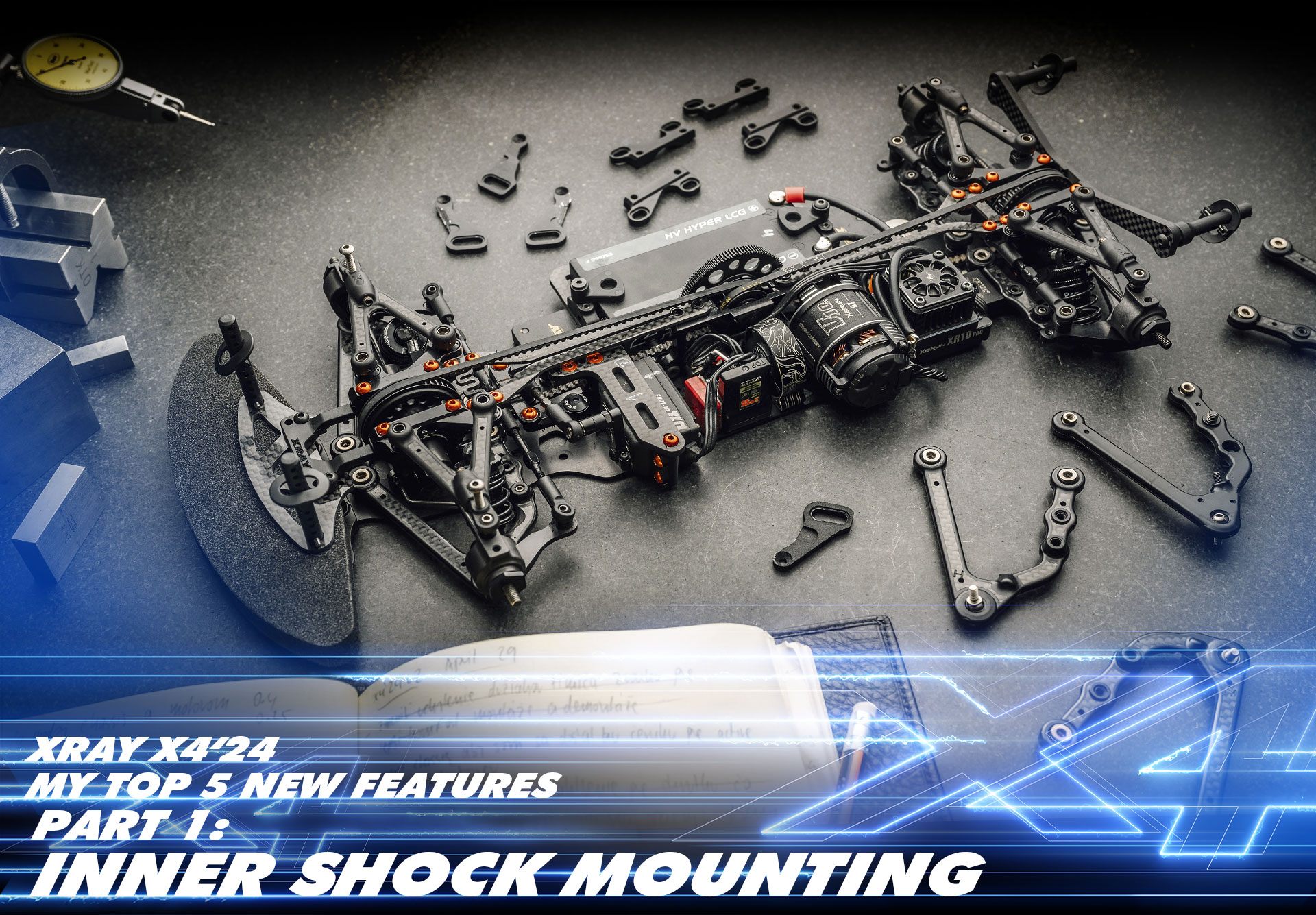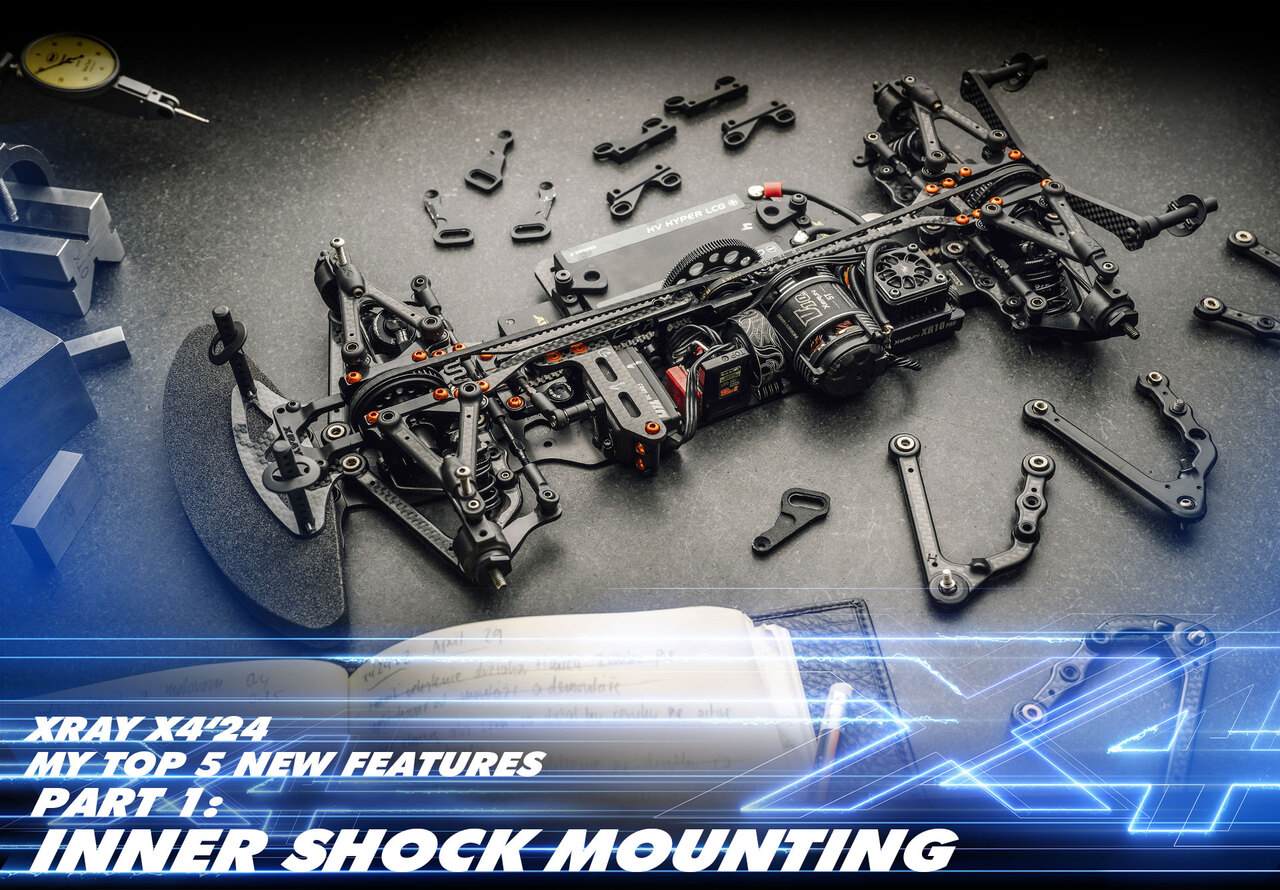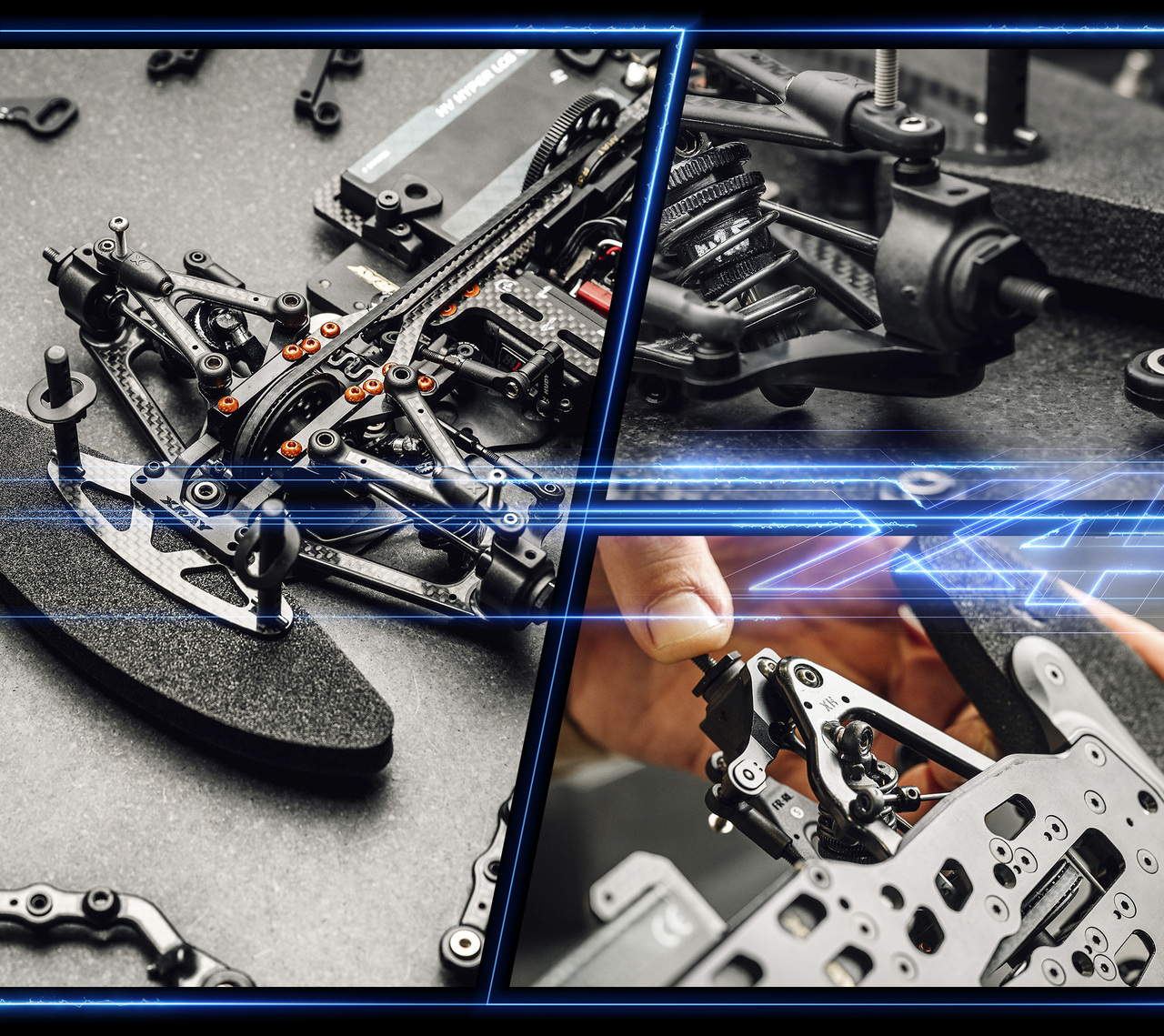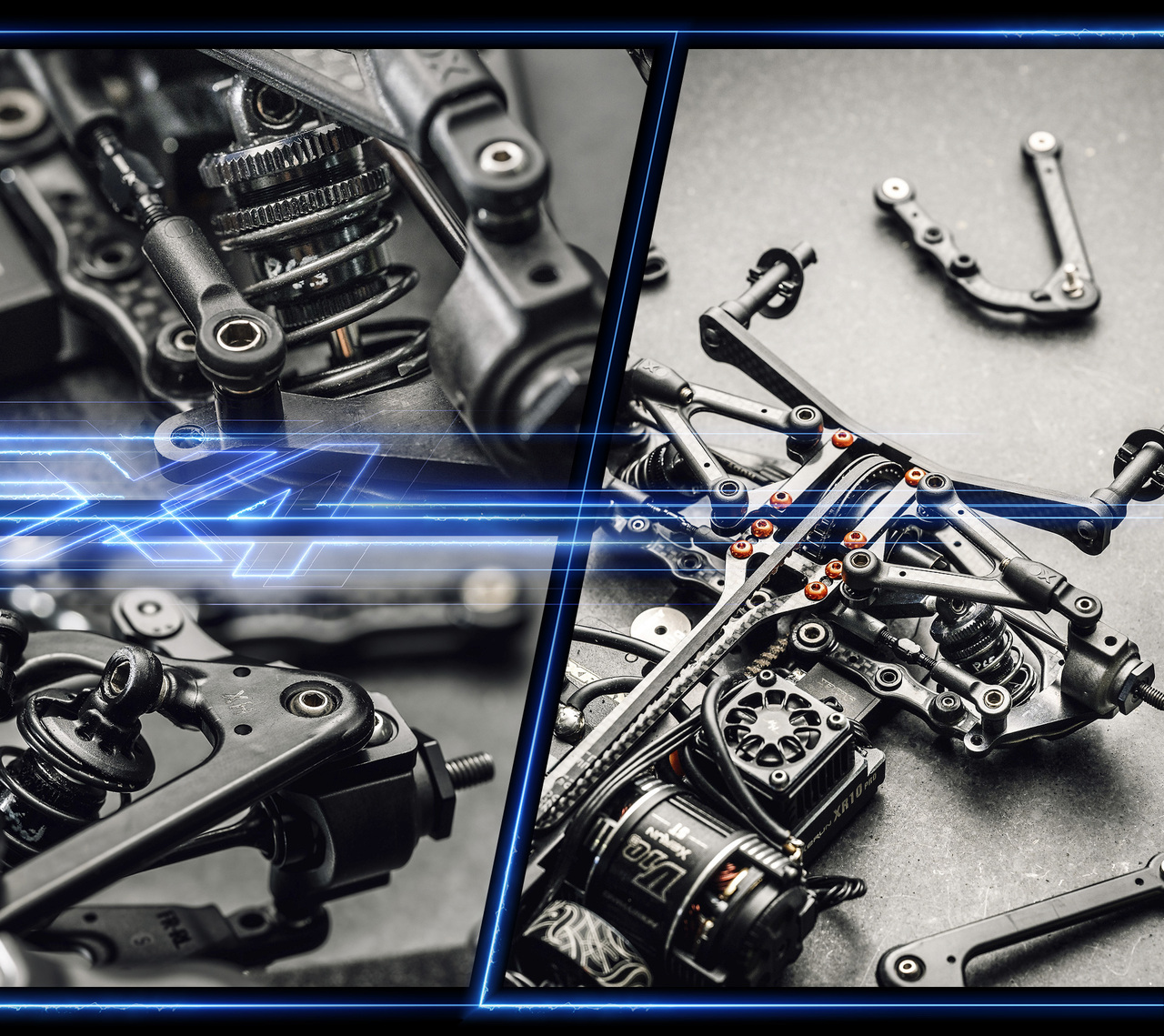

When looking at what could be improved on the very successful X4’23, I initially felt we would be focusing on smaller refinements to the X4 platform to continue to advance the level of performance. In the end, after a lot of design work at the computer and extensive testing by the team, the new car has many more significant changes than first anticipated but resulted in some great improvements on the track. Once the final production car was in my hands, I knew that all that energy and huge investment needed to make it happen was worth it
Listed below are my favorite 5 new features of the all-new X4’24:


Over the years of development of our TC platforms, we have consistently tried to lower the CG each year to push the performance further. The lower we’ve gone, the more stable the cars have become, increasing cornering speed and drivability. I was challenged by how to continue that pursuit of an even lower CG on the X4’24
The X4’23 lowered shocks and shock towers were such a huge improvement for the handling, and I wanted to find a way to benefit from even lower shocks for the ‘24. To achieve this, I knew it would require new suspension arms. Since we would need to heavily invest into a new arm design, I was thinking about other ways to change the new arms to improve other characteristics beyond just lowering the shock position.


In theory, the shocks work the best when they are as close to the drivetrain as possible. The dampening will be more precise, and with the shocks closer to the drivetrain in the front, it will provide a more precise steering feel, and the car will be more responsive, and with better cornering speed. Similarly, in the rear, moving the shocks in front of the rear axle will help to generate better control and more forward traction. To achieve this positioning, I knew there would be many problems and challenges in this design, but I was motivated to face these obstacles because of the anticipated performance benefits.


We decided to proceed even though it required many different design versions, alternatives, redesigned parts, and a lot of 3D printed prototypes. Both the front and rear shock placements were challenging for different reasons, and I tried many alternatives to be able to place the shocks in front and behind the drive shafts both in the front and rear suspension, until eventually arriving at the final design.


The first suspension arms with the inner shock mount concept were created in October of 2022. Since then, a lot of time was spent in front of the computer, creating 18 different design alternatives and 12 different 3D printed versions, until the final version became the production arm which was finished in June 2023. In this time frame, we also made a rapid prototype aluminum mold for the arms in November so that the team could start testing as early as possible
We had to make this mold because testing the 3D printed samples does not give reliable track test data. The molds were necessary to perform realistic tests and confirm that this arm design was the correct decision to improve the performance of the car
We considered moving the rear shocks in front of the driveshafts already on the T4 in 2018, but at the time we were still using the rearward motor position, and moving the shocks on that car did not make for proper weight balance. That car had good rotation and cornering speed, but on-power to off-power transitions suffered.


With the change to the mid-motor position on the X4, that weight transfer issue is not present, and we achieve the desired benefits from moving the shocks. There was still the challenge to package all the steering and driveline components around the new shock locations and allow for all the necessary tuning adjustments, but we felt it was clearly the best approach for the X4 platform
Both the front and rear arms presented some unique design challenges. The front arm requires shock placement as close to the driveshaft as possible while still allowing clearance for the steering arm at full lock. Additionally, both the front and rear arms require sufficient material around the shock mounting area to avoid unwanted flex and to maintain good durability in case of a crash.


The arms’ shapes also need to provide enough clearance to prevent wheels from touching when at full steering through or at full suspension travel. The biggest challenge to overcome was clearance for VTA wheels, which have a completely different shape and offset than regular TC wheels, and required many modifications and tests to find an adequate solution. In the final design, I was able to move the shocks close enough to the drive shafts, and thanks to special cut outs in the molded composite part, the VTA wheel clearance issues were also resolved.
I really liked the original V shape of the X4 upper arms, and these arms were used for the initial X4’24 prototype testing, after modifying the upper shock composite cap to create the necessary clearance between the shock and upper arm. However, I knew that we would need to redesign the upper arm for production to make sure that the shock could be installed and removed comfortably.


One of my key goals with any design project is that the car must be user friendly, and it must not only be easy but also enjoyable to work on. For this reason, I was facing the challenge to design the upper arm in the way that the shock can be installed/removed comfortably, but at the same time maintaining the sleek look of the suspension design. Of course, durability is always a priority when designing any XRAY platform, and must be considered with any new concept
After making 6 different alternatives, I eventually came up with a satisfactory design which fulfilled all three requirements. I was trying to avoid changing the design of the upper clamps, since the ’24 car would already feature so many redesigned parts, but in the end, I had to give up on this idea for the sake of a sleek and cool looking upper arm design that also met the function and durability requirements for the project.


Improving the design of the ECS system to eliminate the need for thread lock has been a desire of mine for some time. Our ECS design was challenging to assemble properly for many of our customers who do not have time for a super precise service approach. Some customers did not use thread lock at all, or inadequate amounts, and after a couple runs a set screw would come loose during a run, resulting in a loose pin that would destroy the steering block. On the other hand, some customers added too much thread lock, which locked the drive shaft assembly and caused binding. These issues caused customer dissatisfaction as well as negative car performance
There were aftermarket brands that offered an ECS clip system where the clip captured the pin, but I was not happy with this solution because the clips would stretch over time and pop off from the ECS allowing the pins to escape from that type of assembly as well
I saw drivers using heat shrink over the clip-on design to stop it from happening. However, this did not meet my desire to simplify the maintenance process for our customers or provide the required durability. My teammate, Ben Cosgrove, contacted me and asked why we do not use the SCS system that we created for the X4 wheel hub assembly and implement it on the ECS drive shaft assembly too.


Since we had successfully introduced a new hex system with SCS a year prior, which made many customers happy, with some even claiming that it was the most valuable improvement of the 23 version, I agreed that this was a very good suggestion. Even though it is just small detail to improve the customer experience during assembly, it required a lot of tests to make sure the clip can be inserted on the ECS case comfortably, and that the sleeve can be easily inserted and removed.
Thanks to our in-house production, I could make various cases and sleeves with different inner diameters to find the best compromise between ease of installing the clip and the necessary security to avoid lost clips and on-track failures. After repeatedly assembling and disassembling the new ECS case, I concluded that the selected clip stayed in place even after extensive use and maintenance. Even though the new SCS ECS system can only be considered a small detail on the new car, it still required a lot of testing and research to make sure it all works as intended.


One significant challenge created by the new inner shock position was the anti-roll bar position. Basically, the shocks were now in the exact position where the anti-roll bars previously were. My first thought was to position the wire on the back of the bulkheads, but as soon as I had the first 3D printed prototype, and I tried to install and remove the wire a few times, I quickly realized that this was not the right solution, as it was simply too complicated.
I came back to the front mounted anti-roll bar design, but there wasn’t much space. We wanted to avoid a complicated wire bar with multiple angles. The only solution was to place the bar super low, in a way where the wire would be placed under the suspension arm. This was the only solution that prevented collision with the shock absorber.


There wasn’t much space underneath the suspension arms either, especially because no parts of the suspension could protrude below the bottom of the chassis line. Since the anti-roll bars don’t need to absorb a lot of impact forces – they are protected inside of the car - I was able to make a super tiny design of all anti-roll bar parts that not only saved weight, but also saved a lot of space.
Even though the anti-roll bar is placed very low, it was also very important for me that a driver can easily adjust the anti-roll bar lifting point to avoid any suspension tweak. To achieve this, I decided to integrate the anti-roll bar mounting ball into the arm. Once again, this was challenging as both a design concept and manufacturable solution, but in the end, the extensive work paid off. When changing the anti-roll bar wires on the prototype car,


I knew that it would not be as easy as on the original X4, but I tried to make it as user friendly and convenient as possible. I added special chamfers in the bulkheads for easier insertion of the ball bearings, as well as a wider wire in the center, with bigger radiuses for easier placement of the wire into the bulkheads. I put maximum effort into the smallest details. The comfort is still not exactly like with the original X4, but on the other hand, I achieved the best that is possible from the bars’ new positions, and the performance gains surely outweigh this small inconvenience in car assembly. As a matter of fact, we rarely change the anti-roll bar thickness. More often than not, we stay with the basic setting for both carpet and asphalt surfaces.


When placing the shocks inside the suspension arms, I knew that there was no way to use the traditional XRAY shock mounting system, and we had to change to a shim alternative. I still wanted to come up with something new and unique, and I was thinking about how to unlock every possible benefit from a new mounting system.
I decided to integrate an active damping option into the new shock holders. The active mount was not new on the market, but I decided to go for a unique 2-in-1 design. I designed the holders in the way that with the removal of a single screw I could make the holders active, and by inserting the screw back, I could make it fixed. Other manufacturers did not have this 2-in-1 system, and therefore I was very pleased that we would introduce this new feature. At the time when the team tested the prototypes in December and January both on carpet and asphalt, the feedback was that they do not like the active holders in the front since it makes the car unprecise. Therefore, I decided to make the front shock holder fixed, without the active option, to reduce the overall weight of the car, as well as the number of parts.


Unfortunately, in the springtime, a 2-in-1 system was introduced by another manufacturer. This was very frustrating for me since I spent a lot of time on this design and was excited to come up with this idea. As a result, I was undecided whether we should keep the active rear holder or change it into a fixed-only holder. I was very proud of the design of the holder, as it was rather unique, and it did not look like a shock holder at all. It looked cool, it looked light, it looked technical, and therefore I decided to keep it in the production car.
When designing the holders, once again I wanted to make the car user friendly. I wanted to avoid the use of thread lock for the set screw installation, and I wanted to make sure that when a customer removes the shock, the set screw would not untighten as well. I was considering a type of screw with centering diameter which will function as a stopper to make sure that it would not move. I did not want to make any special screw - but when browsing the book of normalization tables, I was lucky to find the exact screw type that I was looking for. It was enough just to find the correct placement for the set screw in the way that the screw will extend from the holder to fulfill the range of the desired shock shims.


When thinking about the new design of the shock holders and their position, I still wanted to bring something more interesting, something which would bring even more benefits from this new mounting system. This led to the concept of three different choices for mounting the shock holders to the car.
The flex of the car is one of the most important factors that influences a car’s performance, and for that reason, the X4’24 shock holders give more flex setting options with 3 mounting alternatives. The alternatives are – to mount the shock holders only to the chassis, or only to the bulkheads, or both at the same time. I was surprised by the noticeable effect it has on the car’s handling, and very happy to have made this design decision.
I am very proud of the overall result and the final design of the all-new X4’24. From the initial thoughts of making only a few improvements, we ended up with almost 70% of the parts being redesigned and improved. I am confident that everyone will like the new car and will enjoy the improved performance. Thanks to the entire XRAY team who helped me with the R&D process and testing.
See you at the track and have fun.
